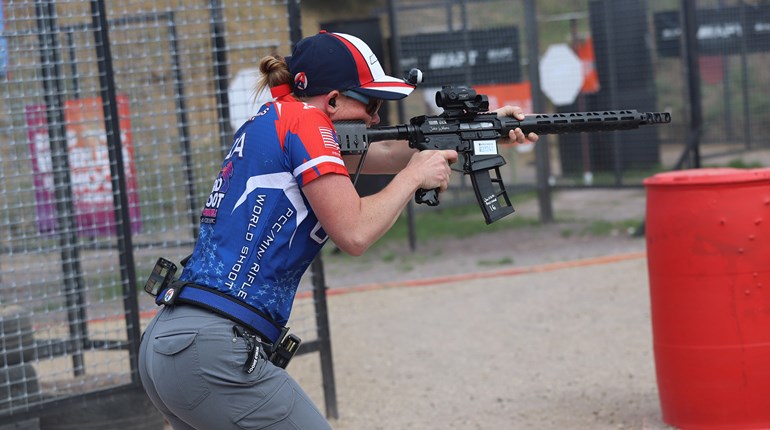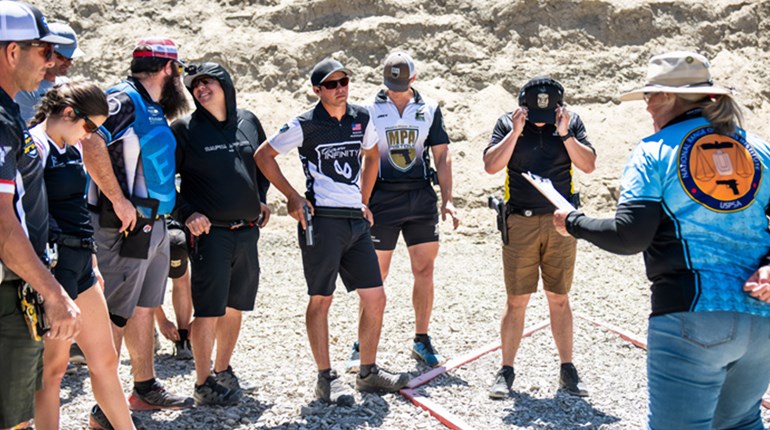** When you buy products through the links on our site, we may earn a commission that supports NRA's mission to protect, preserve and defend the Second Amendment. **
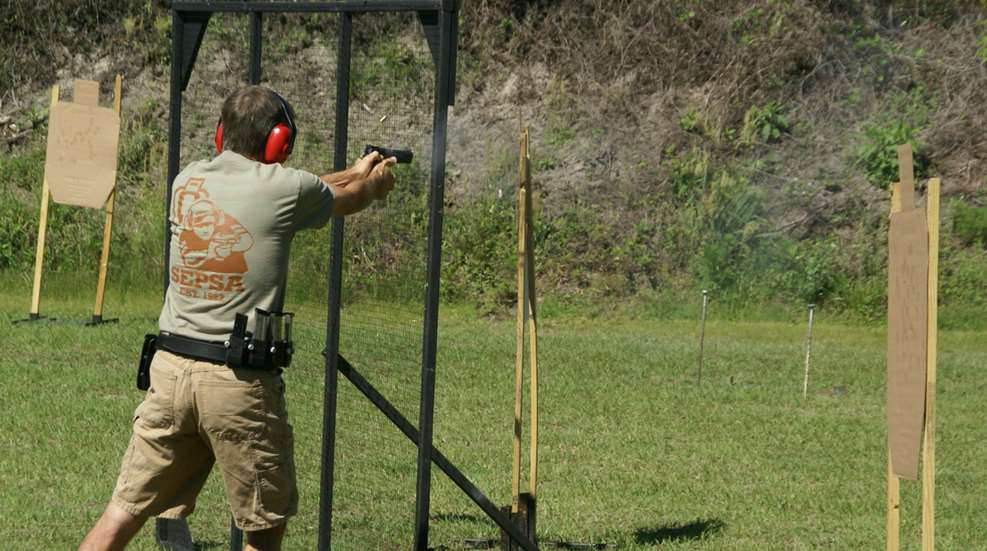
Above: When targets are close, the double tap gives a shooter a scoring advantage—if they know when to use it.
Competitors in IDPA, USPSA and ICORE know that the vast majority of paper targets require two scoring hits. The shooting technique used to make them can significantly affect their score.
Some targets, especially those with No Shoots or Hardcover snuggled up next to them, will require slowing down to deliver precision shots. [Note: See Chris Christian’s previous training article “Focusing on Precision” for background information on precision action shooting.] But the targets that are wide open, which will be the majority of targets, can be shot a lot faster. There are two handgun techniques that can deliver those two rapid hits—Controlled Pairs (CP) and Double Taps (DT).
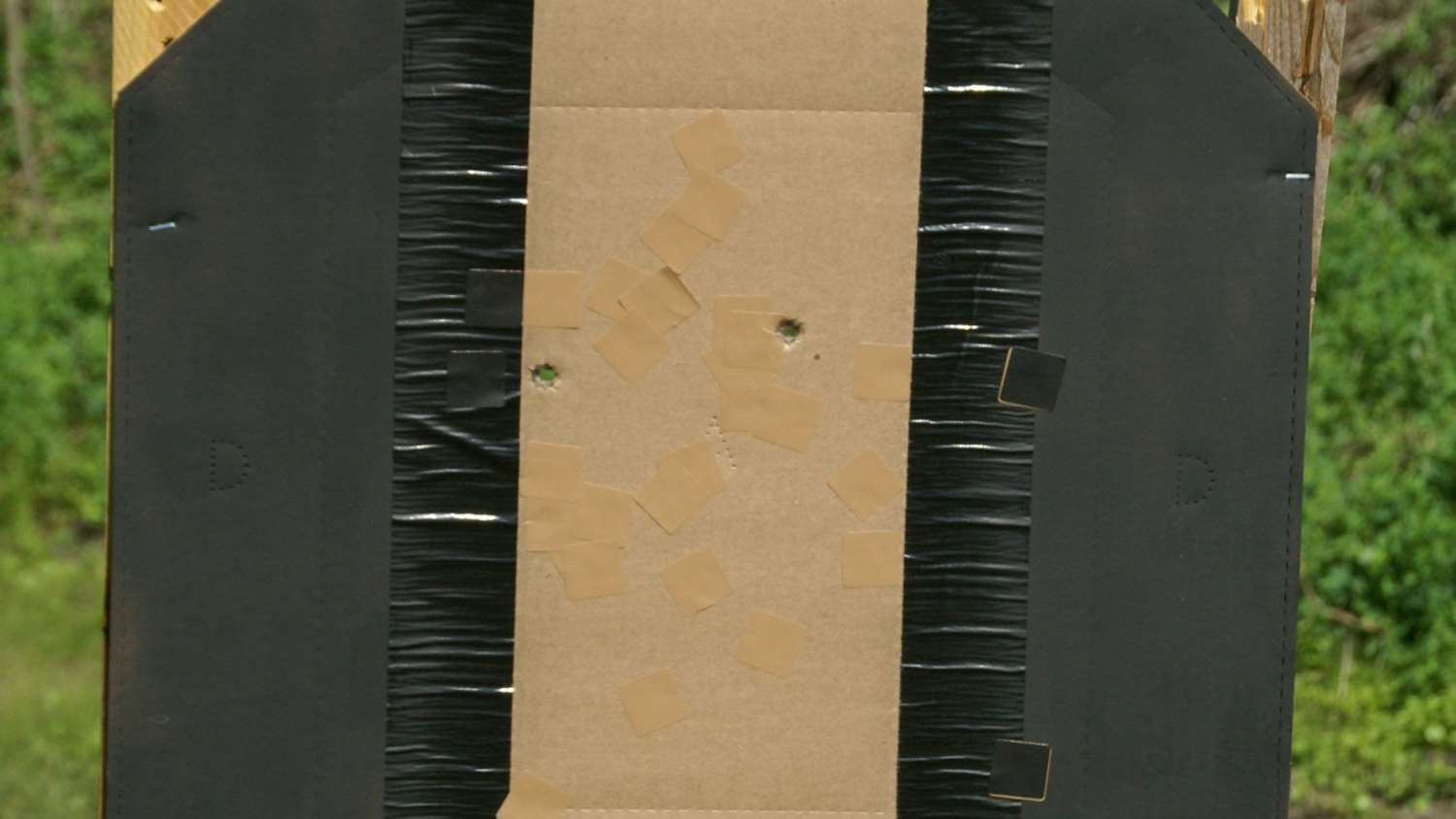 With the Controlled Pair technique the shooter achieves a sight picture for the first shot, triggers that, and then allows the front sight to settle back down for an acceptable sight picture before triggering the second shot (the split). The advantage to CPs is they allow a shooter to achieve A or 0 Zone accuracy over varying distances. Those varying distances will also affect the split time. As target distances increase, so does an ‘acceptable sight picture’, which results in longer split times. For experienced shooters the split times on CPs will run from .45 to .80 seconds during the course of a match with varying target distances. An average split time of .60 seconds is realistic.
With the Controlled Pair technique the shooter achieves a sight picture for the first shot, triggers that, and then allows the front sight to settle back down for an acceptable sight picture before triggering the second shot (the split). The advantage to CPs is they allow a shooter to achieve A or 0 Zone accuracy over varying distances. Those varying distances will also affect the split time. As target distances increase, so does an ‘acceptable sight picture’, which results in longer split times. For experienced shooters the split times on CPs will run from .45 to .80 seconds during the course of a match with varying target distances. An average split time of .60 seconds is realistic.
A true Double Tap (called ‘Hammers’ in the tactical world) is two rounds triggered from one sight picture. The gun is presented to the target, the sight picture achieved, and the trigger pressed twice as fast as the trigger finger will move. There is no attempt to reacquire the sights for the second shot. The theory is that at closer ranges the recoil will not throw the second round very far from the first.
The advantage to DT is pure speed. There are some shooters who can get their split times down into the sub-.20 second range, but for most shooters the splits will fall into the .25 to .35 second range; with revolvers nearing the upper end. Most shooters can easily achieve a .30 split with minimal practice.
That fraction of a second difference in split times may not look like much at first glance. But in a 100 round match, with all paper targets that require two scoring hits, there will be 50 splits. The shooter running .30 second DT splits will spend .15 seconds of their score achieving them. A shooter using all CP splits (with a .60 average time) will be spending around .30 seconds to achieve their second hit. That .15-second difference is huge in the final standings! And a clear advantage to the Double Tap.
Unfortunately, there is also a drawback. That .15 second scoring advantage is only realized if the DT split hits are of equal scoring value to those achieved by the CP shooter. If they start wandering into significant penalty zones, or miss the target entirely, the penalty points make that advantage disappear quickly and become a negative.
The key to gaining the Double Tap time advantage, and avoiding the penalty pitfalls, is to determine the maximum target range where the second shot will land close enough to the first shot to score well. The maximum distance at which a shooter can keep their DTs within the no penalty target zone is as far as they want to push that technique. After that distance is determined, Controlled Pairs become a better scoring bet. The drill to find that target distance is easy to do.
Start at five yards. Some shooters with a background in Bullseye will have trouble making themselves trigger two rounds on one sight picture. It goes against all previous training and experience. Their mental computer is not programed to do it. I suggest starting from Low Ready position. Bring the gun up and make yourself trigger those two rounds from the first sight picture. It can be a new learning experience and one has to reprogram their ‘mental computer’. It becomes easier with repetition. Once the computer is‘re-programmed’, shooters can then shift to a holstered start.
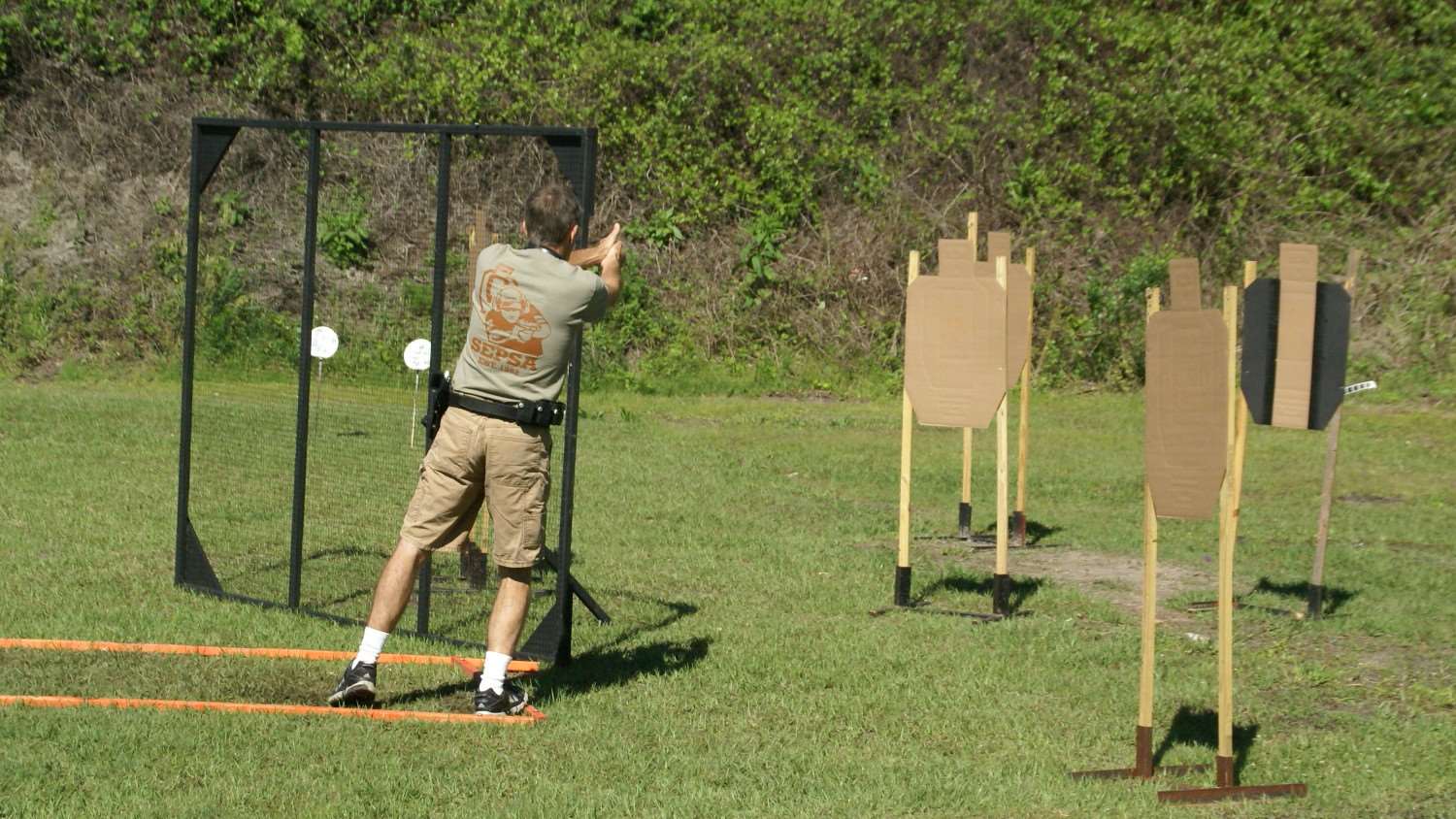 The targets can be appropriate for the discipline being shot. Or just use a 6 x 9 inch piece of paper. That mimics the sweet spot on IDPA, USPSA and ICORE targets. The target can be taped to any cardboard backing.
The targets can be appropriate for the discipline being shot. Or just use a 6 x 9 inch piece of paper. That mimics the sweet spot on IDPA, USPSA and ICORE targets. The target can be taped to any cardboard backing.
Shooters with a sloppy grip may find this five yard distance eye-opening, and prompt them to correct their grip. But with a bit of practice virtually any shooter can achieve good scoring pairs at this range. Then it is time to begin stepping back to find the range where they can’t do it.
Some shooters may find 10 yards is their maximum effective distance. Others may be able to push the DT to the 12 to 15-yard range. Regardless of the personal limitations, that knowledge is valuable.
As shooters in all the above disciplines approach a stage they will be given a walkthrough to look things over. Savvy shooters use this to establish their “stage plan”—where to move, where to reload, and how to get through the stage in the fastest possible time. Knowing their effective DT distance also tells them the shooting techniques they need to use on different targets.
Even if target distances only allow them to use the Double Tap for half of the targets, that’s still six to eight seconds off their score. That will move them up the leaderboard.
Competitors in IDPA, USPSA and ICORE know that the vast majority of paper targets require two scoring hits. The shooting technique used to make them can significantly affect their score.
Some targets, especially those with No Shoots or Hardcover snuggled up next to them, will require slowing down to deliver precision shots. [Note: See Chris Christian’s previous training article “Focusing on Precision” for background information on precision action shooting.] But the targets that are wide open, which will be the majority of targets, can be shot a lot faster. There are two handgun techniques that can deliver those two rapid hits—Controlled Pairs (CP) and Double Taps (DT).

Even a hard cover target can be double tapped if the shooter is confident of the range.
A true Double Tap (called ‘Hammers’ in the tactical world) is two rounds triggered from one sight picture. The gun is presented to the target, the sight picture achieved, and the trigger pressed twice as fast as the trigger finger will move. There is no attempt to reacquire the sights for the second shot. The theory is that at closer ranges the recoil will not throw the second round very far from the first.
The advantage to DT is pure speed. There are some shooters who can get their split times down into the sub-.20 second range, but for most shooters the splits will fall into the .25 to .35 second range; with revolvers nearing the upper end. Most shooters can easily achieve a .30 split with minimal practice.
That fraction of a second difference in split times may not look like much at first glance. But in a 100 round match, with all paper targets that require two scoring hits, there will be 50 splits. The shooter running .30 second DT splits will spend .15 seconds of their score achieving them. A shooter using all CP splits (with a .60 average time) will be spending around .30 seconds to achieve their second hit. That .15-second difference is huge in the final standings! And a clear advantage to the Double Tap.
Unfortunately, there is also a drawback. That .15 second scoring advantage is only realized if the DT split hits are of equal scoring value to those achieved by the CP shooter. If they start wandering into significant penalty zones, or miss the target entirely, the penalty points make that advantage disappear quickly and become a negative.
The key to gaining the Double Tap time advantage, and avoiding the penalty pitfalls, is to determine the maximum target range where the second shot will land close enough to the first shot to score well. The maximum distance at which a shooter can keep their DTs within the no penalty target zone is as far as they want to push that technique. After that distance is determined, Controlled Pairs become a better scoring bet. The drill to find that target distance is easy to do.
Start at five yards. Some shooters with a background in Bullseye will have trouble making themselves trigger two rounds on one sight picture. It goes against all previous training and experience. Their mental computer is not programed to do it. I suggest starting from Low Ready position. Bring the gun up and make yourself trigger those two rounds from the first sight picture. It can be a new learning experience and one has to reprogram their ‘mental computer’. It becomes easier with repetition. Once the computer is‘re-programmed’, shooters can then shift to a holstered start.

The pre-stage walk through allows shooters to visualize the targets, and their distances, to determine the best shooting technique for each target.
Shooters with a sloppy grip may find this five yard distance eye-opening, and prompt them to correct their grip. But with a bit of practice virtually any shooter can achieve good scoring pairs at this range. Then it is time to begin stepping back to find the range where they can’t do it.
Some shooters may find 10 yards is their maximum effective distance. Others may be able to push the DT to the 12 to 15-yard range. Regardless of the personal limitations, that knowledge is valuable.
As shooters in all the above disciplines approach a stage they will be given a walkthrough to look things over. Savvy shooters use this to establish their “stage plan”—where to move, where to reload, and how to get through the stage in the fastest possible time. Knowing their effective DT distance also tells them the shooting techniques they need to use on different targets.
Even if target distances only allow them to use the Double Tap for half of the targets, that’s still six to eight seconds off their score. That will move them up the leaderboard.














